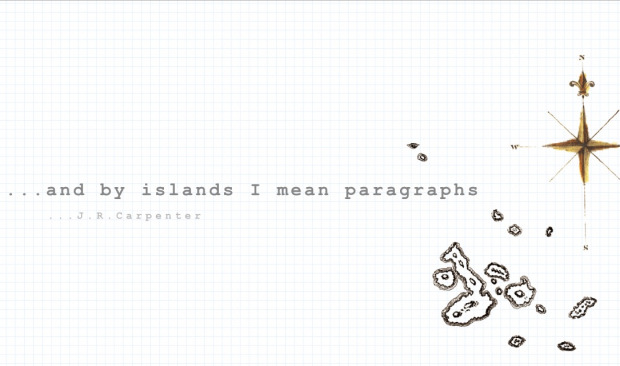A Topographical Approach to Re-Reading Books about Islands in Digital Literary Spaces
This paper takes a topographical approach to re-reading print books in digital literary spaces through a discussion of a web-based work of digital literature “…and by islands I mean paragraphs” (Carpenter 2013). In this work, a reader is cast adrift in a sea of white space extending far beyond the bounds of the browser window, to the north, south, east and west. This sea is dotted with computer-generated paragraphs. These fluid texts call upon variable strings containing words and phrases collected from a vast literary corpus of books about islands. Individually, each of these textual islands represents a topic – from the Greek topos, meaning place. Collectively they constitute a topographical map of a sustained practice of reading and re-reading and writing and re-writing on the topic of islands. This paper will argue that, called as statement-events into digital processes, fragments of print texts are reconstituted as events occurring in a digital present which is also a break from the present. A new regime of signification emerges, in which authorship is distributed and text is ‘eventilized’ (Hayles). This regime is situated at the interface between an incoherent aesthetics, one which tends to unravel neat masses, including well-known works of print literature; and an incoherent politics, one which tends to dissolve existing institutional bonds, including bonds of authorship and of place. Alexander Galloway terms this regime of signification the ‘dirty regime of truth’.
(Souce: ELD 2015)
Today topography is generally associated with cartography. A topographic map locates topics—such as elevation, population, forestation, and rainfall—on a map in a graphic manner. But in classical times topography referred to geographers’ written descriptions of places. A topos is a place in discourse and a place in the world. Through topos, location and narration are inextricably linked. Susan Barton, the castaway narrator of J. M. Cotzee’s novel Foe asks: “Is that the secret meaning of the word story, do you think – a storing-place of memories?” (1986: 59). The practices of textual and visual topography aim to locate topics in memory. In Writing Space: Computers, Hypertext, and the Remediation of Print, Jay David Bolter argues that with the advent of digital writing topos are now located in the data structure of the computer (29). As such, he writes: “Electronic writing… is not the writing of a place, but rather a writing with places as spatially realized topics” (36). In a programming language like C, variables indeed refer to specific locations in computer memory. In a programming language like JavaScript, however, the operation of processes including memory are distributed across networks and devices. The arguments a variable refers to may be located anywhere. Once it has been referred to, through a process known as garbage collection, an argument may disappear. Or, the reference to it may disappear. JavaScript’s mode of dispersed, temporary, and transitory memory allocation is well suited to the re-reading, re-searching, and re-writing of transient, variable texts.
Works referenced:
Critical writing referenced:
Platforms referenced:
| Title | Developers | Year initiated |
|---|---|---|
| JavaScript | 1995 |


